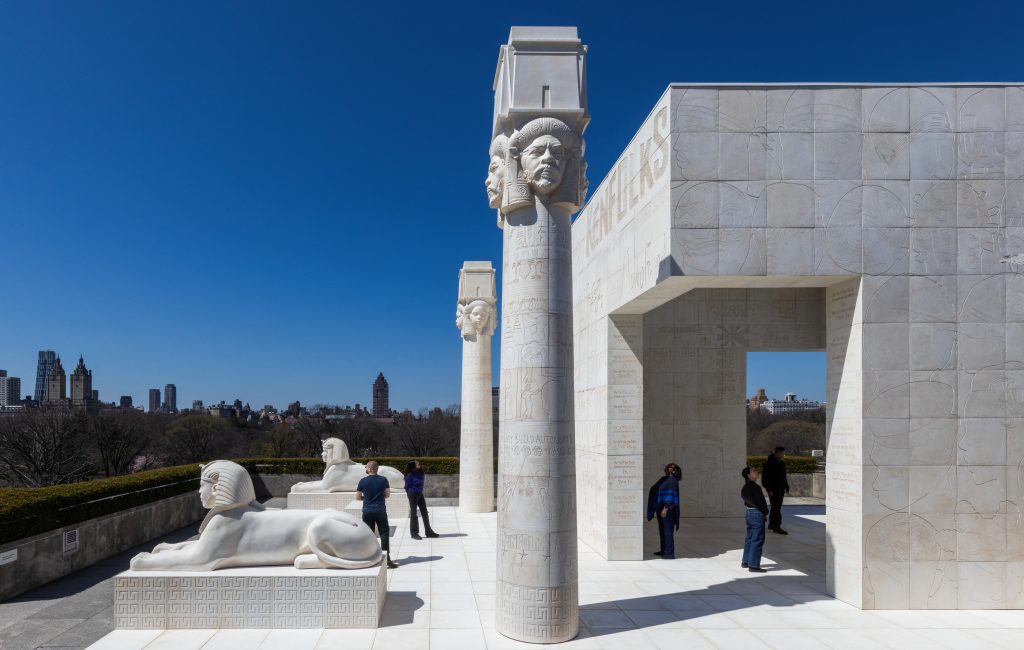Some artists make debuts so electric it lights up an uncharted space in your mind. Think of Jean-Michel Basquiat in 1982 or Matthew Barney a decade later. Last year the breakout star was Lauren Halsey, whose inaugural show for the Chelsea outpost of Los Angeles’s David Kordansky Gallery excited every corner of the New York art world., Now, just a year later, the 35-year-old Angeleno has reached its pinnacle, namely the tenth annual rooftop garden commission from the Metropolitan Museum of Art.
“Lauren is a once-in-a-generation artist,” Kordansky boasted at the exhibition’s 17 April opening. “She’s incredible,” said the Los Angeles County Museum of Art director Michael Govan, one of Halsey’s hometown posse of supporters to make the trip. “Amazing!” concurred the artist Mark Bradford, a friend and sometime mentor. Let me put it another way. Halsey’s installation atop the Met is a triumph of public sculpture: a 22ft-high, Modernist, pharaonic temple that connects Afrofuturism to the museum’s Hatshepsut, it is flanked by four inscribed columns and guarded by four regal sphinxes.
For all its welcome, the Met roof is a difficult space for an artist to command. Its expansive views of the city skyline and Central Park don’t really need enhancement. Even monumental sculptures can look small there, and installations of many objects can get lost in crowds of visitors—an unlikely proposition this time around. In fact, the temple is visible from the ground in the park.
Monumental in every way
“This is the best rooftop show since Big Bambú,” one guest observed, referring to the giant, climbable bamboo nest erected in 2010 by the Starn Twins for a rooftop series that preceded the commissioned shows. I asked Mike Starn what he thought about that. “It occupies the space with grace and gravity,” he replied, gazing at Halsey’s gypsum-toned monument to urban Blackness, one that reaches back to antiquity while documenting the present. “And it speaks to the humanity of the city, and especially to the people marginalised by this museum for so long.”
Exactly. Speaking for myself, a white person who has been sickened by the racial divisions in America throughout her life, Halsey’s celebration of community is an equalising joy. And if she is about any one thing, it’s community.
Made of 750 fibre-reinforced concrete tiles and titled the eastside of south central los angeles hieroglyph prototype architecture (l), the walls of Halsey’s pavilion, inside and out, are covered in hand-carved collages of the signage, cars, graffiti and funk/hip-hop music that contribute to the visual and aural culture of the neighbourhood where the artist grew up and still lives. Faces carved into the columns’ capitals portray Halsey’s neighbours; those on the sphinxes represent her immediate family, but they also testify to human history. That’s what makes her project so inclusive. It’s minimalist architecture as maximalist social commentary. And it’s genius.
Halsey studied architecture at a community college before moving on to fine art at the California Institute of the Arts and Yale University. Since her 2015 residency at the Studio Museum in Harlem, she exhibited her work in a group show there. Since then, she’s been unstoppable, showing solo and in groups, while one museum after another added her to their collections. In 2018, top prize in the Hammer Museum’s Made in L.A. biennial went to her installation, elements of which anticipated her current work at the Met. In 2019 she won the Frieze New York Artist Award and in 2021, the Gwendolyn Knight & Jacob Lawrence Prize at the Seattle Art Museum.
“It was Lauren’s background as an architect that made me think of her,” said Sheena Wagstaff, the Met’s former head of Modern and contemporary art and the initial commissioner of Halsey’s project. (Abraham Thomas, curator of Modern architecture and design oversaw it.) “The whole piece is extraordinary, but,” Wagstaff confided, “I think Lauren tested this institution more than any other artist I’ve worked with, except Doris Salcedo at Tate Modern, but that’s what she should do and why we’re here. Coming a week after the glam opening of Cecily Brown’s masterful exhibition, Death and the Maid, the Grand Old Met is absolutely on fire.



Comment here